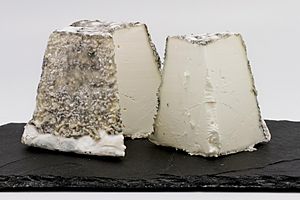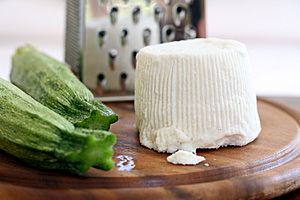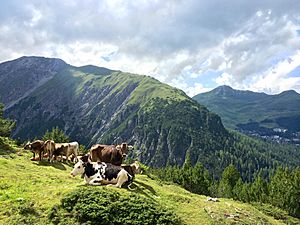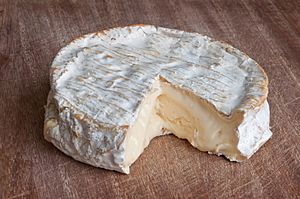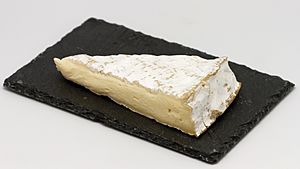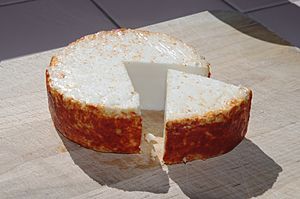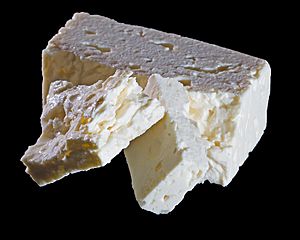Types of cheese facts for kids
There are many different types of cheese. People group cheeses in various ways. They might look at how long a cheese is aged, how soft or hard it is, or what kind of milk was used. The most common way to group cheeses is by how much water they have, then by their fat content, and finally by how they are aged. No single way of grouping cheese is used everywhere.
Experts have found hundreds, even thousands, of different cheese types! Some people have tried to create simpler ways to classify them. One idea was to group them by how they are made and how much moisture they contain. Another idea was to group them by their production methods, which resulted in 18 main types.
Contents
Fresh and Whey Cheeses
The main thing about these cheeses is that they are young. Fresh cheeses don't have many added things to keep them from spoiling, so they can go bad in just a few days.
To make these simple cheeses, milk is made into curds (solid parts) and then drained. Not much else is done to them. Some examples are cottage cheese, cream cheese, and paneer. These cheeses are often soft and easy to spread. They usually have a mild flavor.
Whey cheeses are fresh cheeses made from whey. Whey is the liquid left over after making other cheeses. Instead of throwing it away, cheesemakers use it! Examples include Italian ricotta and Norwegian Brunost. Corsican brocciu is often eaten fresh and is a big part of Corsican cooking.
Some fresh cheeses, like fromage blanc, are often eaten as desserts.
Stretched Curd Cheeses
This group of cheeses is often called pasta filata, which is Italian for "spun paste." In these cheeses, the hot curds are stretched, usually by machines. This stretching creates different textures.
Many traditional stretched curd cheeses, like Italian mozzarella and halloumi, are also fresh cheeses. Fresh curds are stretched and kneaded in hot water to make a ball of mozzarella. In southern Italy, mozzarella is often eaten just hours after it's made. It's famous worldwide for pizza!
But not all stretched curd cheeses are fresh. Italian provolone and caciocavallo are hard or semi-hard and are aged. Oaxaca cheese from Mexico is semi-hard but not aged. Many types of string cheese are also made this way.
Cooked Pressed Cheeses
Swiss-type cheeses, also known as Alpine cheeses, are hard or semi-hard cheeses with a special taste. They first came from the Alps mountains in Europe. They are called "cooked" because they are made using special bacteria that like high heat (45°C or more). They are also "pressed" to squeeze out extra water. This is why they are called "cooked pressed cheeses."
These cheeses became special because they were made in the summer on high mountain pastures. Then, they were carried down to the valleys with the cows in the winter. Traditionally, these cheeses were made in large, round "wheels" with a hard rind. This made them strong enough to keep and transport.
Famous examples made from cow's milk include Swiss Emmental and Gruyère. French cheeses like Beaufort and Comté are also in this group. Most modern versions are made in factories and are often rectangular blocks.
Alpine cheeses usually have a firm but springy texture. Their flavor is not sharp or salty, but more nutty and buttery. When melted, they become gooey and stretchy.
Another group of cooked pressed cheeses are the very hard Italian "grana" cheeses. The most famous are Parmesan and Grana Padano. These cheeses also use a similar process to Alpine cheeses. They use more salt and less heating, which suited the local area.
How Hard or Soft is the Cheese?
Grouping cheeses by how much water they have, or how firm they are, is common. But it's not always exact. The lines between soft, semi-soft, semi-hard, and hard can be blurry. Many cheeses come in both softer and firmer versions. The amount of water in a cheese controls how hard it is. This depends on how much pressure is used when it's put into molds and how long it is aged.
Soft Cheese
Cream cheeses are not aged at all. Brie and Neufchâtel are soft cheeses that age for only a short time, usually less than a month. Neufchâtel can be sold after just 10 days of aging.
Semi-Soft Cheese
Semi-soft cheeses have a lot of water and usually taste mild. Well-known types include Havarti, Munster, and Port Salut.
Medium-Hard Cheese
Cheeses that range from semi-soft to firm include Swiss-style cheeses like Emmental and Gruyère. The same bacteria that make the "eyes" (holes) in these cheeses also give them their strong and sharp flavors. Other cheeses in this group are Gouda and Edam. These cheeses are great for melting and are often used on toast for quick meals.
Semi-Hard Cheese
Harder cheeses have less water than softer ones. They are usually pressed into molds with more pressure and aged longer. Cheddar is a very famous semi-hard to hard cheese. It started in a village called Cheddar in England. Now, "Cheddar" is a general name for this style of cheese. Different types are sold based on how strong they taste or how long they have been aged.
Cheddar is part of a family of cheeses where the curds are cut, gently heated, piled up, and stirred before being pressed. Colby and Monterey Jack are similar but milder. Their curds are rinsed before pressing, which washes away some of the acidity. A similar rinsing happens when making the Dutch cheeses Edam and Gouda.
Hard Cheese
Hard cheeses, like Grana Padano, Parmesan, or Pecorino, are often used for grating. They are packed very firmly into large molds and aged for many months or even years.
What Kind of Milk is Used?
Some cheeses are grouped by the type of milk used to make them. Most cheese sold around the world is made from cow's milk. But many places also make cheese from goats and sheep. For example, Roquefort (from France) and Pecorino (from Italy) are made from ewe's (female sheep) milk. In Greece, feta cheese is made from sheep's milk.
Double cream cheeses are soft cow's milk cheeses that have extra cream added. This means they have a high fat content. Triple cream cheeses have even more cream, making them very rich.
Cheeses with Mold
There are three main types of cheese where mold is a key part of their character: soft-ripened cheeses, washed-rind cheeses, and blue cheeses.
Soft-Ripened Cheeses
Soft-ripened cheeses start out firm and a bit chalky. But they are aged from the outside in by being exposed to mold. This mold might be a soft, white layer of Penicillium camemberti. This mold creates a flexible white crust and helps make these aged cheeses smooth, runny, or gooey. It also gives them stronger flavors. Brie and Camembert are the most famous soft-ripened cheeses. They are made by letting white mold grow on their outside for a few days or weeks. Goat's milk cheeses are often treated this way too.
Washed-Rind Cheeses
Washed-rind cheeses are soft and ripen from the outside in, like soft-ripened cheeses. However, they are treated differently. Washed-rind cheeses are regularly washed with a solution of salty water or other things like beer, wine, or spices. This makes their surfaces good for a type of bacteria (Brevibacterium linens) that gives them strong smells and special flavors. These bacteria also create a firm, flavorful rind around the cheese. Washed-rind cheeses can be soft (Limburger), semi-hard, or hard (Appenzeller). This process needs regular washing, especially when the cheese is young.
Smear-Ripened Cheeses
These cheeses are also "smear-ripened" with solutions of bacteria or fungi. This usually gives them a stronger flavor as they age. Sometimes, older cheeses are smeared onto younger ones to share the tiny living things. Many of these cheeses have a special pinkish or orange color on the outside. The washing helps make sure the right bacteria or fungi grow and stops unwanted molds. Examples include Munster and Port Salut.
Blue Cheeses
Blue cheese is made by adding special molds like Penicillium roqueforti. This is done when the cheese is still in loose curds. Cheesemakers might also poke holes in the cheese as it ages. This helps the mold grow inside. These cheeses have clear blue veins, which gives them their name. They often have strong flavors. The molds can be pale green to dark blue. Their texture can be soft or firm. Some of the most famous blue cheeses are Roquefort, Gorgonzola, and Stilton.
Granular Cheeses
Granular cheese is a type of cheese made by stirring and draining a mix of curds and whey many times. This group includes the "grana cheeses" like Parmesan.
Brined Cheeses
Brined or pickled cheese is aged in a salty water solution (brine) in a sealed container. This process helps the cheese stay good, even in hot places, by stopping bad bacteria from growing. Brined cheeses can be soft or hard. They come in different colors and flavors depending on the milk used. They don't have a rind. They usually taste clean, salty, and a bit sour when fresh. When aged, they get a little spicy. Most are white. Examples of brined cheese include bryndza, feta, and halloumi. Brined cheese is a very common type of cheese in the Middle East and Mediterranean areas.
Processed Cheese
Processed cheese is made from traditional cheese mixed with special salts. It often has milk, more salt, things to keep it fresh, and food coloring added. It has a smooth texture and melts easily. It is sold in packages, either already sliced or in blocks. Some are sold in sausage-like shapes. You might also know "Easy Cheese", which comes in a spray can!
Some processed cheeses are made using leftover pieces of real cheese, whey powders, and different vegetable oils or fats. Some slices of processed cheese have very little actual cheese in them. Some even have smoke flavors added.


